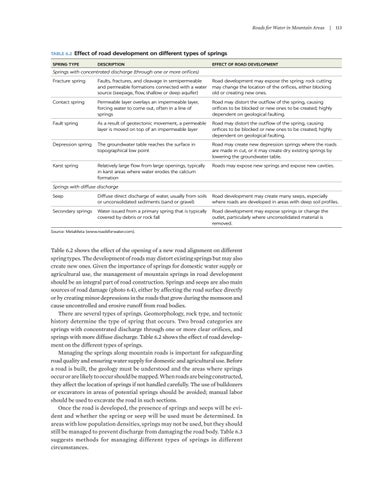Roads for Water in Mountain Areas | 113
TABLE 6.2 Effect
of road development on different types of springs
SPRING TYPE
DESCRIPTION
EFFECT OF ROAD DEVELOPMENT
Springs with concentrated discharge (through one or more orifices) Fracture spring
Faults, fractures, and cleavage in semipermeable and permeable formations connected with a water source (seepage, flow,,shallow or deep aquifer)
Road development may expose the spring; rock cutting may change the location of the orifices, either blocking old or creating new ones.
Contact spring
Permeable layer overlays an impermeable layer, forcing water to come out, often in a line of springs
Road may distort the outflow of the spring, causing orifices to be blocked or new ones to be created; highly dependent on geological faulting.
Fault spring
As a result of geotectonic movement, a permeable layer is moved on top of an impermeable layer
Road may distort the outflow of the spring, causing orifices to be blocked or new ones to be created; highly dependent on geological faulting.
Depression spring
The groundwater table reaches the surface in topographical low point
Road may create new depression springs where the roads are made in cut, or it may create dry existing springs by lowering the groundwater table.
Karst spring
Relatively large flow from large openings, typically in karst areas where water erodes the calcium formation
Roads may expose new springs and expose new cavities.
Springs with diffuse discharge Seep
Diffuse direct discharge of water, usually from soils or unconsolidated sediments (sand or gravel)
Road development may create many seeps, especially where roads are developed in areas with deep soil profiles.
Secondary springs
Water issued from a primary spring that is typically covered by debris or rock fall
Road development may expose springs or change the outlet, particularly where unconsolidated material is removed.
Source: MetaMeta (www.roadsforwater.com).
Table 6.2 shows the effect of the opening of a new road alignment on different spring types. The development of roads may distort existing springs but may also create new ones. Given the importance of springs for domestic water supply or agricultural use, the management of mountain springs in road development should be an integral part of road construction. Springs and seeps are also main sources of road damage (photo 6.4), either by affecting the road surface directly or by creating minor depressions in the roads that grow during the monsoon and cause uncontrolled and erosive runoff from road bodies. There are several types of springs. Geomorphology, rock type, and tectonic history determine the type of spring that occurs. Two broad categories are springs with concentrated discharge through one or more clear orifices, and springs with more diffuse discharge. Table 6.2 shows the effect of road development on the different types of springs. Managing the springs along mountain roads is important for safeguarding road quality and ensuring water supply for domestic and agricultural use. Before a road is built, the geology must be understood and the areas where springs occur or are likely to occur should be mapped. When roads are being constructed, they affect the location of springs if not handled carefully. The use of bulldozers or excavators in areas of potential springs should be avoided; manual labor should be used to excavate the road in such sections. Once the road is developed, the presence of springs and seeps will be evident and whether the spring or seep will be used must be determined. In areas with low population densities, springs may not be used, but they should still be managed to prevent discharge from damaging the road body. Table 6.3 suggests methods for managing different types of springs in different circumstances.







































